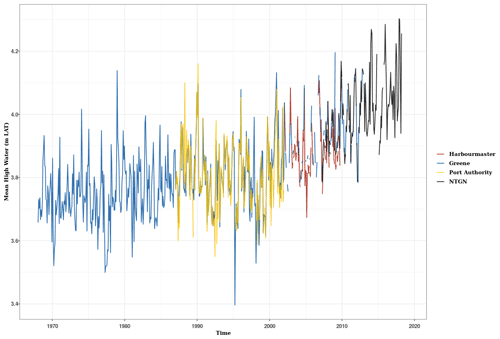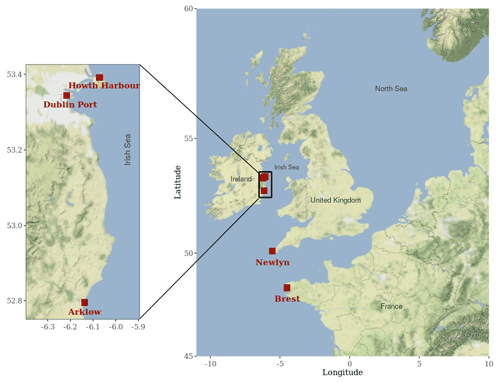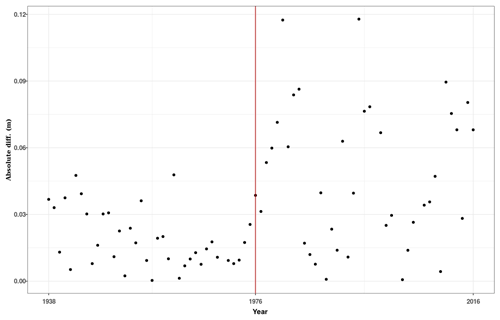the Creative Commons Attribution 4.0 License.
the Creative Commons Attribution 4.0 License.
A newly reconciled dataset for identifying sea level rise and variability in Dublin Bay
Amin Shoari Nejad
Andrew C. Parnell
Alice Greene
Peter Thorne
Brian P. Kelleher
Robert J. N. Devoy
Gerard McCarthy
We provide an updated sea level dataset for Dublin for the period 1938–2016 at yearly resolution. Using a newly collated sea level record for Dublin Port, as well as two nearby tide gauges at Arklow and Howth Harbour, we perform data quality checks and calibration of the Dublin Port record by adjusting the biased high water level measurements that affect the overall calculation of mean sea level (MSL). To correct these MSL values, we use a novel Bayesian linear regression that includes the mean low water values as a predictor in the model. We validate the re-created MSL dataset and show its consistency with other nearby tide gauge datasets. Using our new corrected dataset, we estimate a rate of sea level rise of 1.1 mm yr−1 during 1953–2016 (95 % credible interval from 0.6 to 1.6 mm yr−1), and a rate of 7 mm yr−1 during 1997–2016 (95 % credible interval from 5 to 8.8 mm yr−1). The overall sea level rise is in line with expected trends, but large multidecadal variability has led to higher rates of rise in recent years.
- Article
(1556 KB) - Full-text XML
- BibTeX
- EndNote
The global mean sea level (MSL) is rising due to anthropogenic climate change (Devoy, 2015; Masson-Delmotte et al., 2021). Understanding regional sea level trends is crucial for local and regional adaptation and the development of effective climate action plans. In Ireland, Dublin is the largest city, with a population of approximately 1.42 million (CSO, 2019), and is situated at the mouth of the river Liffey on the Irish Sea coast. Dublin also has the Republic of Ireland’s longest tide gauge record (from 1938 onwards): the publicly available record for Dublin Port (also called Dublin North Wall). Understanding changes in mean sea level in Dublin is key for the protection of Ireland's largest city and, from a national perspective, for understanding long-term sea level rise (SLR) in Ireland (DCC, 2005).
The sea level around Ireland rose rapidly after the last glacial maximum 20 000 years ago, cutting Ireland off as an island 16 000 years ago (Edwards and Craven, 2017). Regionally, sea levels in Ireland had stabilised by the 20th century, after which sea levels began to rise again due to anthropogenically induced warming (Masson-Delmotte et al., 2021). The importance of climate warming and SLR in Ireland has been emphasised by a number of authors: Devoy (2008) discussed the risks of extreme climatic events and the ways in which Ireland should be prepared for them, while Camaro Garcia et al. (2021) state that satellite observations, which are associated with the open ocean rate, show sea levels rising around Ireland at a rate of 2–3 mm yr−1, in line with global averages for the early 21st century. However, the raw tide gauge record at Dublin Port shows a rate of sea level rise of 0.3 mm yr−1 from 1938 to 2000 (DCC, 2005) – much lower than the global average.
A number of authors have investigated trends in the Dublin Port tide gauge data prior to the year 2000 and have found similarly low rates of change. Carter (1982) investigated the Dublin Port record using tide gauge measurements, and reported a rising trend of 0.6 mm yr−1 before 1961 and a falling trend of −0.3 mm yr−1 from then until 1980. Woodworth et al. (1991, 1999) estimated trends of 0.17 mm yr−1 (± 0.35) from 1938 to 1988, and 0.23 mm yr−1 from 1938 to 1996.
In stark contrast to these low rates of SLR, the recently published climate change action plan for 2019–2024 by Dublin City Council (DCC, 2017) reports an SLR of 6–7 mm yr−1 between the years 2000 and 2016. This rate is approximately double that of the global mean sea level rise (Nerem et al., 2018) and is particularly surprising given that the earlier rates of rise in Dublin were much lower than the global mean sea level rise over similar periods (Dangendorf et al., 2017).
The goal of this paper is to further investigate the sea level trend in Dublin Port through careful assembly and quality control of the available data and by comparing those data with sea level records collected from nearby tide gauges. We find that the datums of Dublin's available sea level measurements are not aligned with those of nearby tide gauges and thus need further consideration. In addition, we find problems with the mean high water measurements, which indicate a drift over time. We use a Bayesian multivariate linear regression to adjust for the drift and, after removing atmospheric factors, we find that the sea level record, at least for the 21st century, matches other local tide gauges to a far higher degree. This allows us to estimate more reliable measurements of sea level rise for the urban area of Dublin Port.
The rest of this paper is organised as follows. Section 2 explains how the sea level dataset for Dublin Port is reconciled from various sources. Section 3 discusses the quality check and calibration procedures done on the reconciled dataset. Section 4 discusses SLR rates at Dublin Port. Finally, some issues and suggestions pertaining to SLR analysis at Dublin Port and the important findings of this study are discussed and summarised in Sect. 5.
We compiled mean high and low water, mean tide level and, where available, mean sea level for Dublin Port from 1938 to 2018 from the following sources:
-
Annual high and low water from Woodworth et al. (1991); PSMSL (2020) for the period 1938–2001 from annual tabulations made by the Dublin Port Authority (hereafter the Port Authority annual dataset). Mean tide level (MTL) was calculated by averaging the mean high and low waters. Data from 1938 to 1977 are relative to Port Datum, which is 0.436 m above the Ordnance Survey Datum Dublin (Poolbeg Datum), and data from 1978 are relative to the lowest astronomical tide (LAT) which is 20 cm above Poolbeg Datum.
-
Monthly values of mean high water (MHW) and mean low water (MLW) for the period of 1987–2001 (hereafter the Port Authority monthly dataset), which were digitised as part of this study. Quality control measures for the digitisation included automatic comparison and checking of the calculated and recorded mean levels. Comparison of the overlapping Port Authority datasets showed a mean difference of ≤1 mm during the 15 overlapping years (1987–2001). Data are reported relative to LAT.
-
High-frequency (10 min) data supplied by the Permanent Service for Mean Sea Level (PSMSL, 2020; Holgate et al., 2013) for the period 2002–2009. These data were provided to the PSMSL by the harbourmaster in Dublin Port following a change in responsible authority in 2001 (hereafter the harbourmaster dataset). The data have a low vertical resolution of 0.1 m and are reported relative to LAT.
-
High-frequency (5 min) data for the period 2007–2018 from the Irish National Tide Gauge Network (NTGN), which is maintained by the Irish Marine Institute (hereafter the NTGN dataset) (IMI, 2019). Data are available relative to Ordnance Datum Malin (ODM) and LAT. All NTGN data are defined relative to ODM and LAT.
-
High water levels for the period 1968–2015. These were digitised as part of an unpublished MSc thesis of Alice Greene (hereafter the Greene dataset) and are published here for the first time. The Greene dataset for the period 1968–1982 was transcribed from photographs of tidal charts from which the high water values can be read. During 1983–2003, the data were recorded in the format of hard-copy tidal charts. The hard copies consisted of three large A3 books. The remaining data from 2003–2013 from which high waters could be derived were in digital format.
With particular reference to the Greene dataset, prior to the availability of digital data in 2003, the high water values for each day were extracted from the tidal charts. This was completed by the generation of tables for each year, with two available cells for each day. These values were read off and input into the designated cell. The data from the period 1968–1976 were converted from feet and inches to metres. To locate the two high tides, for each day, the highest value was extracted. The second high tide occurred between 12 and 13 h before or after the highest value; therefore this value was extracted using the time component of the dataset. In the case where the time window went into the next calendar day, only a single high tide was recorded for that day. A summary of the datasets is shown in Table 1.
Difficulties in merging the Dublin Port datasets arose from differing datum definitions. For both Port Authority datasets, the tabulated annual and monthly data are relative to the same datum. These data have the same source and therefore agreement is expected. Three years of overlap exist between the harbourmaster dataset and the NTGN dataset from 2007–2009. The harbourmaster dataset is relative to LAT datum; the NTGN data are relative to ODM, with a value of 2.599 m between these datums. There is found to be a systematic underestimation of 0.044 m in the MHW and MLW values in the harbourmaster dataset, presumably due to its lower vertical resolution of 0.1 m, determined from the overlap with the NTGN data.
While no overlaps exist between the harbourmaster dataset and the Port Authority dataset, the Greene dataset overlaps the Port Authority, harbourmaster and NTGN datasets. Figure 1 shows monthly MHW from the Port Authority, harbourmaster, NTGN and Greene datasets, each expressed with respect to LAT (note that our monthly data are limited to 1968 onward). There is a high level of agreement between the data, indicative of consistent datums. We find a residual 0.008 m difference between the Greene dataset and the other two datasets (Port Authority monthly dataset and the NTGN dataset). We thus add 8 mm to the Greene dataset as the final datum adjustment.
We now use our newly merged dataset (hereafter the merged Dublin Port dataset) including monthly MLW, MTL, MSL and MHW measurements. In order to check the reliability of the merged Dublin Port dataset, we compare with two different nearby tide gauges (maximum distance 60 km) at Howth Harbour and Arklow, and two other tide gauges at Newlyn in the UK and Brest in France. The Arklow and Howth Harbour datasets are derived from bubbler gauges. The Newlyn and Brest data are gauges with a long history of use in sea level studies (Bradshaw et al., 2016; Wöppelmann et al., 2006). Figure 2 shows the locations of the tide gauges. Table 2 provides the details of the datasets.
Table 2Details of the four datasets used for comparison with Dublin Port.

PSMSL provides both monthly and annual data. We use only annual data that matches our data resolution.
For the Arklow and Howth Harbour datasets, we first aggregate the values up to daily and monthly level for MLW, MSL and MHW. During our pre-processing, we compared MLW, MSL and MHW at Dublin Port with those at Arklow and Howth Harbour. We noticed that the other sites exhibited low levels of agreement with Dublin Port after 2017, so we restricted our analysis to use only data up to the end of 2016.
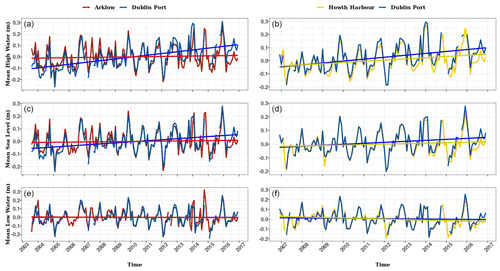
Figure 3Comparison of MHW, MSL and MLW monthly values for Dublin Port against those for Arklow (a, c, e) and Howth Harbour (b, d, f), with linear trends shown for each. The MLW linear trends for Dublin Port and Arklow are in good agreement, as are those for Dublin Port and Howth Harbour. However, this is not the case with the linear trends for MSL and MHW when comparing Dublin Port to the two other locations.
Table 3Differences between rates of SLR in MLW, MSL and MHW for Dublin Port and those for Arklow or Howth Harbour. Large values with small standard errors indicate a significantly higher rate at Dublin Port.

Figure 3 and Table 3 demonstrate that rates of SLR in MSL and MHW are significantly higher in Dublin Port than in Arklow or Howth Harbour. A possible cause is the malfunction of the Dublin Port tide gauge in measuring the high water levels, due to drift. A Druck pressure transducer was used at Dublin Port (Murphy et al., 2003), and this has the potential to exhibit drift proportional to the height of the water column. Accuracies of pressure sensors are reported to be proportional to full water column depth. While drift need not necessarily be proportional to full water column depth, this is a possibility that is supported by further analysis (see next section). Table 4 provides the details of the tide gauges installed at Dublin Port from 1938 to the present.
From Fig. 3, we can see that the MLW values at Dublin port are highly similar to those from nearby gauges, so we use these as a baseline to correct the MSL values. To do this, we create a regression model that estimates MSL given MLW from older Dublin Port measurements. We then use the predictions from this model to estimate MSL at Dublin Port for the more recent period.
To find the period of time over which to train the regression, we use a change point model (Carlin et al., 1992) that takes the absolute difference between MSL values of Dublin Port and Newlyn in the UK as the inputs. Details of the change point model are discussed in the Appendix. The model suggests that there is a change point in the agreement between Dublin and Newlyn in 1976. Furthermore, Fig. 4 shows the comparison of MSL data from Dublin Port (not yet corrected for the bias demonstrated in Fig. 3) with that of Newlyn and Brest in France. These two are selected due to the relative completeness and integrity of their records and their proximity to Dublin. According to the figure, there is strong agreement between stations for MSL in the period 1938–1976. After 1976, the level of agreement deteriorates, which is consistent with the change point model result. Note that this does not necessarily mean that the weaker agreement post-1976 is related to data quality. However, based on these observations, we do not have any evidence supporting the quality of data from 1976 onwards, and so we limited our modelling approach to data from the preceding period.
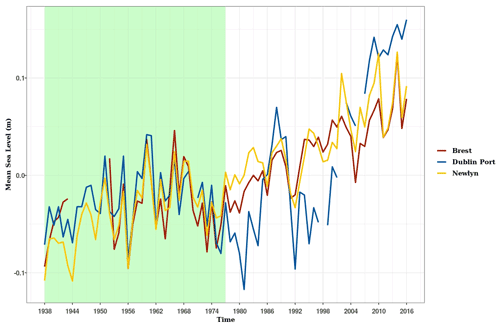
Figure 4Yearly MSL values for Dublin Port, Newlyn and Brest. The green area shows our chosen time period, during which there is good agreement between Dublin Port and the other sites.
We correct the bias in the MSL values at Dublin Port using a Bayesian multivariate linear regression. Our model consists of an intercept, a term proportional to annual MLW, a fixed effect on annual MLWs, a harmonic function with a period of 18.6 years to model the lunar nodal cycle, and a period of 4.4 years to account for the 8.85-year cycle of lunar perigee (Haigh et al., 2011; Woodworth, 2012). The two latter terms will primarily contribute to the astronomical tidal component of MLW. The model formulation is as follows:
where (MSL)t is the MSL in year t, μt is the mean, σ2 is the residual variance, β0 is the intercept, β1 is the MLW coefficient, β2 and β3 are the amplitudes of the cosine and sine functions of the 18.6-year lunar nodal modulation respectively, and β4 and β5 are the amplitudes of the cosine and sine functions of the 4.4-year modulation respectively.
We fitted the model using the JAGS software (Plummer et al., 2003) and R (R Core Team, 2022), and used three Markov chain Monte Carlo chains (2000 iterations per chain with 1000 as burn-in, and a thinning value of 1). Convergence was assessed using the R-hat diagnostic (Brooks and Gelman, 1998; Gelman and Rubin, 1992). All R-hat values associated with β and σ were close to 1, so the model was assumed to be sampling from the posterior distribution. The new estimated MSL and the original values, together with the yearly MSL values of Arklow and Howth Harbour, are shown in Fig. 5. This figure demonstrates that the newly modelled Dublin Port yearly MSL data are changed only slightly between 1938 and 2001. After 2001, we can see a clear gap between the old (red) and new (blue) versions, with the new corrected data exhibiting superior agreement with the Arklow and Howth Harbour records. We note again here that these adjacent records were not used in the creation of the new Dublin Port data so are an independent validation of our approach. The larger adjustment in Fig. 5 after 2001 seems to support the discrepancies shown in Fig. 3 for the higher water levels and provides further justification for our change point calibration approach.
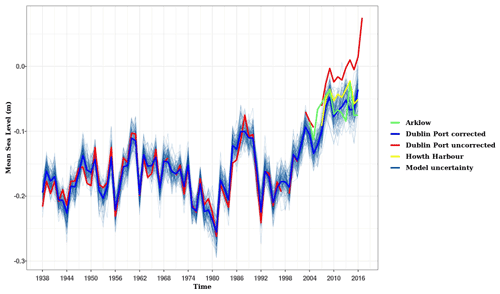
Figure 5The uncorrected and corrected yearly MSL values of Dublin Port, with yearly MSL values of Arklow and Howth Harbour for comparison. The newly corrected Dublin Port MSL values lie much closer to the neighbouring tide gauges. The faded lines in the background show posterior samples from the model and an indication of model uncertainty.
We now use the corrected data from Dublin Port to calculate rates of sea level rise. We use the yearly MSL data from Brest and Newlyn for comparison. The MSL data from Brest is missing between 1944 and 1952, so we decided to limit our SLR rate estimations to 1953–2016, during which the data for all three sites were complete. We first removed the inverse barometer and wind effects on sea level at each site following Frederikse et al. (2017) and Diabaté et al. (2021) (we omitted this step in the previous section due to a lack of atmospheric data during 1938–1948). Atmospheric data are accessed via the RNCEP package (Kemp et al., 2012) in the R programming language, which accesses the National Centers for Environmental Prediction (NCEP)/National Center for Atmospheric Research (NCAR) and Department of Energy Reanalysis I and II datasets (Kalnay et al., 1996; Kanamitsu et al., 2002). Figure 6 shows the atmospherically corrected MSL data from Dublin Port, Brest and Newlyn superimposed for comparison.
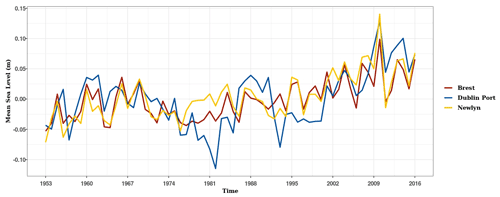
Figure 6New yearly MSL values of Dublin Port and yearly MSL values of Brest and Newlyn, with atmospheric effects removed, between 1953 and 2016.
To calculate the rates of SLR, as before, we use a Bayesian multivariate linear regression, including an intercept and a linear trend. The model is fitted in JAGS with the same settings and convergence requirements as previously described. We write the model as
where (MSL)t is the MSL at time t, μt is the mean, is the fixed variance at time t extracted from the posterior distribution of the calibration model to account for the uncertainty in modelling the MSL introduced in the previous section, σ2 is the residual variance, β0 is the intercept and β1 is the rate in mm yr−1. We use the same approach (but without the fixed measurement error) for estimating the rates of rise at Brest and Newlyn.
The estimated rates with their associated 95 % posterior credible intervals are given in Table 5, which shows that, between 1953 and 2016, the rate of SLR at Dublin Port has a mean estimate of 1.1 mm yr−1, consistent with the estimated rate of 0.9 mm yr−1 at Brest and that of 1.3 mm yr−1 at Newlyn. However in more recent years, specifically between 1997 and 2016, Dublin Port has experienced a greater SLR of 7 mm yr−1, larger than the SLRs of 2.3 mm yr−1 at Brest and 3.1 mm yr−1 at Newlyn. Figure 6 also suggests that sea level in Dublin Port has experienced larger decadal fluctuations and is not as secular as the sea level at the two other locations.
Taken over the full time period of observations, 1953–2016, the estimated sea level rise of 1.1 mm yr−1 in Dublin is consistent with those in Brest and Newlyn, both of which are located on the western European coastline. The rates of rise for earlier periods (i.e. pre-1953) are less than 1.1 mm yr−1 (Carter, 1982; Woodworth et al., 1991) and are consistent with the findings here, and were lower because the decades of larger sea level rise and variability (1980s, 2000s) were not included in the trend estimation. Elsewhere in Ireland, Orford et al. (2006) investigated tide gauge records in Malin Head (1958–1998) and Belfast harbour (1918–2002), where they reported substantial annual variation for both sites, with overall negative trends of −0.2 mm yr−1 for Belfast and −0.16 mm yr−1 for Malin Head. Both Belfast and Malin Head, being in the north of the country, are in regions of uplift due to glacial isostatic adjustment (GIA), which reduces the relative sea level rise there. However, Dublin is in a region of neutral glacial isostatic uplift, so these long-term effects of post-glacial land motion should be negligible and hence greater consistency of the local sea level rise rates with the global figure is to be expected (Bradley et al., 2011).
More surprising is the large decadal variability revealed. This study has found a rate of sea level rise for Dublin of −2.9 mm yr−1 for the period 1975–1985, followed by another negative sea level trend in the next decade (−8.6 mm yr−1 during 1986–1996) and a rise of 7 mm yr−1 for the period 1997–2016. Similar patterns of decadal variability in sea level to those in Dublin were also noted in Belfast by Orford et al. (2015) and are linked to decadal variation of the North Atlantic Oscillation. This would seem a likely explanation for similar patterns in Dublin. However, a full investigation of the causes of decadal variability in Dublin sea level remains to be performed.
Comparisons of the MLW, MSL and MHW recordings at Dublin Port suggest a possible issue with the observation of high water levels. Our model recreated the MSL and showed that there is good agreement between the observed MSL and the modelled MSL for the period 1938–2001. However, after 2001 there is considerable divergence. Our analysis shows that the modelled MSL is more consistent with the data collected by the nearby tide gauges and also at the farther sites in Newlyn and Brest. This suggests that the malfunction probably started during or after the year 2002. We would consider the Howth Harbour sea level record, alongside the modelled MSL data created in our study, as the more reliable dataset for a future analysis of sea level in Dublin Bay compared to the data collected at Dublin Port.
Dublin City Council have recently increased the coastal defences in Dublin, allowing for between 40 and 65 cm of mean sea level rise (O'Connell, 2019). Projections of sea level rise for Dublin, based on UKCP18 (Fung et al., 2018), depend heavily on greenhouse gas emissions trajectories. By 2100, the Dublin mean sea level is projected to rise by 0.6 m at the 50th percentile (1.0 m at the 95th percentile) under an RCP8.5 scenario and by 0.3 m at the 50th percentile level (0.6 m at the 95th percentile level) under an RCP2.6 scenario. These projections do not simulate the decadal scale variability reported here, similar to many other decadal climate phenomena. Understanding the origin and duration of the decadal fluctuations of mean sea level in Dublin is crucial for the preparation and defence of Ireland's capital city in the coming decades.
To sum up, we have collated multiple sources of tide gauge data for Dublin Port, and subsequently corrected them for bias in the MHW level. We have then shown that these corrected MSL measurements agree with both Howth Harbour and Arklow to a far higher degree than the raw data. A longer-term comparison with Brest and Newlyn also indicates overall agreement. There remains a difference during the 1970s and the 1980s, where a large cyclic disparity in Dublin contrasts with the other two records. Our final adjusted dataset estimated the rate of SLR at Dublin Port to be 1.1 mm yr−1 between 1953 and 2016, and 7 mm yr−1 between 1997 and 2016.
The work we present here is part of a broader aim to improve sea level records in Ireland through the multi-centre Aigéin, Aeráid, agus athrú Atlantaigh (A4) project. A recent example is that of the now corrected tide gauge record in Cork City (Pugh et al., 2021). A deeper focus on the coastal environs of Dublin is also under way through the Predict Project funded by Science Foundation Ireland. We hope to report elsewhere on further records that may provide a fuller picture of SLR in Ireland.
To identify the period of data to use in calibrating the Dublin Port MSL and MLW values (see Fig. 4), we use a linear regression change point model (Carlin et al., 1992). The model we use can be formulated as follows:
where yt is the absolute difference between the measured mean sea levels at Dublin Port and Newlyn in year t (). We assume yt to be normally distributed with mean μt and variance σ2. The mean is set to α1 if t<tc and α1+α2 otherwise, and tc is the time of the change point. The function u(t) is the unit step function. We used vague prior distributions for all parameters:
Figure A1 shows the absolute difference between the MSLs of Dublin Port and Newlyn. The vertical red line indicates the posterior mean of the change-point estimate tc.
The codes used in this study are available on Github (https://github.com/Aminsn/Dublin-Bay-SLR, last access: 20 April 2022).
Dublin Port annual mean sea-level data (corrected as a result of this study for measurement bias) from 1938 to 2016 plus historical datasets described in Table 1 are available in CSV format from here: https://doi.org/10.5281/zenodo.6338475 (Shoari Nejad et al., 2021). Data from the Irish National Tide Gauge Network, maintained by the OPW (Arklow) and the Marine Institute (Dublin Port, Howth), are available from https://waterlevel.ie/ (OPW, 2021) and http://www.irishtides.ie (Marine Institute, 2021), respectively.
ASN, ACP and GM originated the study. The analysis was performed by ASN. AG and PT created the high water dataset. All authors contributed to the writing of the manuscript.
The contact author has declared that neither they nor their co-authors have any competing interests.
Publisher’s note: Copernicus Publications remains neutral with regard to jurisdictional claims in published maps and institutional affiliations.
Amin Shoari Nejad's work was supported by Science Foundation Ireland Investigator Award grant 16/IA/4520. Andrew Parnell's work was supported by a Science Foundation Ireland Career Development Award (17/CDA/4695), a research centre award (12/RC/2289-P2), and an investigator award (16/IA/4520). Gerard McCarthy and Andrew Parnell were supported by the Marine Institute and the Marine Research Programme 2014–2020 through the A4 project (Grant-Aid Agreement no. PBA/18/CC/01). The author has applied a CC BY public copyright licence to any author accepted manuscript version arising from this submission.
This research has been supported by the Science Foundation Ireland (grant no. 16/IA/4520).
This paper was edited by John M. Huthnance and reviewed by Philip Woodworth and Sarah Bradley.
Bradley, S., Milne, G., Shennan, I., and Edwards, R.: An improved glacial isostatic adjustment model for the British Isles, J. Quaternary Sci., 26, 541–552, 2011. a
Bradshaw, E., Woodworth, P., Hibbert, A., Bradley, L., Pugh, D., Fane, C., and Bingley, R.: A century of sea level measurements at Newlyn, Southwest England, Mar. Geod., 39, 115–140, 2016. a
Brooks, S. and Gelman, A.: General methods for monitoring convergence of iterative simulations, J. Comput. Graph. Stat., 7, 434–455, 1998. a
Camaro Garcia, W., Dwyer, N., Barrett, F., Berry, A., Cronin, M., Cusack, C., Gallagher, S., Gault, J., Gill, M., Gleeson, E., Hanley, J., Kane, P., Lambkin, K., Lawlor, R., Lydon, K., Lyons, K., Martin, D., McCarthy, G., McGovern, E., Murphy, C., Nolan, G., Nugent, C., O’Dwyer, B., Ovadnevaite, J., Quinlan, C., Saunders, M., Silke, J., Smith, G., Thomas, R., Walsh, S., Westbrook, G., Eoin, W., and Wilkes, R.: Climate Status Report for Ireland, Tech. Rep., EPA, https://www.epa.ie/publications/research/climate-change/Research_Report_386.pdf (last access: 20 April 2022), 2021. a
Carlin, B. P., Gelfand, A. E., and Smith, A. F.: Hierarchical Bayesian analysis of changepoint problems, J. Roy. Stat. Soc. Ser. C, 41, 389–405, 1992. a, b
Carter, R.: Sea-level changes in Northern Ireland, P. Geologist. Assoc., 93, 7–23, 1982. a, b
CSO: Central Statistics Office: Population and Migration Estimates April 2020, https://www.cso.ie/en/csolatestnews/pressreleases/ (last access: 8 September 2021), 2019. a
Dangendorf, S., Marcos, M., Wöppelmann, G., Conrad, C., Frederikse, T., and Riva, R.: Reassessment of 20th century global mean sea level rise, P. Natl. Acad. Sci. USA, 114, 5946–5951, 2017. a
DCC: Dublin City Council: Dublin Coastal Flooding Protection Project, Report No. 9M2793., Tech. Rep., Report for Dublin City Council, drafted by: Owen Mc Manus, Ian Cooke, John Greenyer, https://www.fingal.ie/sites/default/ (last access: 20 April 2022), 2005. a, b
DCC: Dublin city council: Climate change action plan, https://www.dublincity.ie/residential/environment/ (last access: 10 April 2022), 2017. a
Devoy, R.: Coastal vulnerability and the implications of sea-level rise for Ireland, J. Coast. Res., 24, 325–341, 2008. a
Devoy, R. J.: Sea-level rise: causes, impacts, and scenarios for change, in: Coastal and Marine Hazards, Risks, and Disasters, Elsevier, 197–241, https://doi.org/10.1016/B978-0-12-396483-0.00008-X, 2015. a
Diabaté, S. T., Swingedouw, D., Hirschi, J. J.-M., Duchez, A., Leadbitter, P. J., Haigh, I. D., and McCarthy, G. D.: Western boundary circulation and coastal sea-level variability in Northern Hemisphere oceans, Ocean Sci., 17, 1449–1471, https://doi.org/10.5194/os-17-1449-2021, 2021. a
Edwards, R. and Craven, K.: Relative Sea-Level Change Around the Irish Coast, in: Advances in Irish Quaternary Studies, 181–215, edited by: Coxon, P., McCarron, S., and Mitchell, F., Atlantis Press, https://doi.org/10.2991/978-94-6239-219-9, 2017. a
Frederikse, T., Simon, K., Katsman, C. A., and Riva, R.: The sea‐level budget along the Northwest Atlantic coast: GIA, mass changes, and large‐scale ocean dynamics, J. Geophys. Res.-Ocean., 122, 5486–5501, 2017. a
Fung, F., Palmer, M., Howard, T., Lowe, J., Maisey, P., and Mitchell, J.: UKCP18 Factsheet: Sea Level Rise and Storm Surge, Tech. Rep., Met Office Hadley Centre, Exeter, https://www.metoffice.gov.uk/binaries/content/ (last access: 20 April 2022), 2018. a
Gelman, A. and Rubin, D.: Inference from iterative simulation using multiple sequences, Stat. Sci., 7, 457–472, 1992. a
Haigh, I. D., Eliot, M., and Pattiaratchi, C.: Global influences of the 18.61 year nodal cycle and 8.85 year cycle of lunar perigee on high tidal levels, J. Geophys. Res.-Ocean., 116, C6, https://doi.org/10.1029/2010JC006645, 2011. a
Holgate, S., Matthews, A., Woodworth, P., Rickards, L., Tamisiea, M., Bradshaw, E., Foden, P., Gordon, K., Jevrejeva, S., and Pugh, J.: New Data Systems and Products at the Permanent Service for Mean Sea Level, J. Coast. Res., 29, 493–504, 2013. a
IMI: Irish Marine Institute website, https://erddap.marine.ie/erddap/ (last access: 1 September 2021), 2019. a
Kalnay, E., Kanamitsu, M., Kistler, R., Collins, W., Deaven, D., Gandin, L., Iredell, M., Saha, S., White, G., Woollen, J., Zhu, Y., Leetmaa, A., Reynolds, R., Chelliah, M., Ebisuzaki, W., Higgins, W., Janowiak, J., Mo, K., Ropelewski, C., Wang, J., Jenne, R., and Joseph, D.: The NCEP/NCAR 40-year reanalysis project, Bull. Am. Meteorol. Soc., 77, 437–471, 1996. a
Kanamitsu, M., Ebisuzaki, W., Woollen, J., Yang, S.-K., Hnilo, J., Fiorino, M., and Potter, G.: NCEP–DOE AMIP-II Reanalysis (R-2), Bull. Am. Meteorol. Soc., 83, 1631–1643, 2002. a
Kemp, M. U., Emiel van Loon, E., Shamoun-Baranes, J., and Bouten, W.: RNCEP: global weather and climate data at your fingertips, Method. Ecol. Evol., 3, 65–70, 2012. a
Marine Institute: Tidal Observations, Marine Institute [data set], available at: http://www.marine.ie/Home/site-area/data-services/real-time-observations/tidal-observations, last access: 11 December 2021. a
Masson-Delmotte, V., Zhai, P., Pirani, A., Connors, S. L., Péan, C., Berger, S., Caud, N., Chen, Y., Goldfarb, L., Gomis, M. I., Huang, M., Leitzell, K., Lonnoy, E., Matthews, J., Maycock, T. K., Waterfield, T., Yelekçi, O., Yu, R., et al. (Eds.): IPCC, 2021: Summary for Policymakers, in: Climate Change 2021: The Physical Science Basis, Contribution of Working Group I to the Sixth Assessment Report of the Intergovernmental Panel on Climate Change, Tech. Rep., Cambridge University Press, https://www.ipcc.ch/report/ar6/wg1/downloads/report/IPCC_AR6_WGI_Full_Report.pdf (last access: 20 April 2022), 2021. a, b
Murphy, J., Sutton, G., O'Mahony, C., and Woodworth, P.: Scoping Study to Assess the Status of Irelands Tide Gauge Infrastructure and Outline Current and Future Requirements, Tech. Rep., https://www.psmsl.org/train_and_info/ (last access: 20 April 2022), 2003. a
Nerem, R., Beckley, B., Fasullo, J., Hamlington, B., Masters, D., and Mitchum, G.: Climate change driven accelerated sea level rise detected in the altimeter era, P. Natl. Acad. Sci. USA, 115, 2022–2025, 2018. a
O'Connell, G.: Interview on Pat Kenny Newstalk: Is Catastrophic Dublin flooding inevitable?, https://www.newstalk.com/podcasts/ (last access: 1 September 2021), 2019. a
OPW: GPRS Stations, OPW [data set], avaiable at: https://waterlevel.ie/, last access: 11 December 2021. a
Orford, J. and Murdy, J.: Presence and possible cause of periodicities in 20th-century extreme coastal surge: Belfast Harbour, Northern Ireland, Glob. Planet. Change, 133, 254–262, 2015. a
Orford, J., Murdy, J., and Freel, R.: Developing constraints on the relative sea-level curve for the northeast of Ireland from the mid-Holocene to the present day, Philos. T. R. Soc. A, 364, 857–866, 2006. a
Plummer, M. et al.: JAGS: A program for analysis of Bayesian graphical models using Gibbs sampling, in: Proceedings of the 3rd international workshop on distributed statistical computing, Vol. 124, 1–10, Vienna, Austria, 2003. a
PSMSL: Permanent Service for Mean Sea Level (PSMSL), Tide Gauge Data, http://www.psmsl.org/data/obtaining (last access: 21 January 2022), 2020. a, b
Pugh, D. T., Bridge, E., Edwards, R., Hogarth, P., Westbrook, G., Woodworth, P. L., and McCarthy, G. D.: Mean sea level and tidal change in Ireland since 1842: a case study of Cork, Ocean Sci., 17, 1623–1637, https://doi.org/10.5194/os-17-1623-2021, 2021. a
R Core Team: R: A language and environment for statistical computing, R Foundation for Statistical Computing, Tech. Rep., Vienna, Austria, https://www.R-project.org/ (last access: 21 January 2022), 2022. a
Shoari Nejad, A., McCarthy, G., Parnell, A. C., Thorne, P., Kelleher, B. P., Devoy, R. J. N., and Greene, A.: Dublin's Corrected Mean Sea Level (1938–2016), Zenodo [data set], https://doi.org/10.5281/zenodo.6338475, 2021. a
Woodworth, P., Shaw, S., and Blackman, D.: Secular trends in mean tidal range around the British Isles and along the adjacent European coastline, Geophys. J. Int., 104, 593–609, 1991. a, b, c
Woodworth, P., Tsimplis, M., Flather, R., and Shennan, I.: A review of the trends observed in British Isles mean sea level data measured by tide gauges, Geophys. J. Int., 136, 651–670, 1999. a
Woodworth, P. L.: A note on the nodal tide in sea level records, J. Coast. Res., 28, 316–323, 2012. a
Wöppelmann, G., Pouvreau, N., and Simon, B.: Brest sea level record: a time series construction back to the early eighteenth century, Ocean Dynam., 56, 487–497, 2006. a
- Abstract
- Introduction
- Data collation for Dublin Port
- Reconciliation of Dublin Port against nearby tide gauges
- Rates of sea level rise at Dublin Port and nearby gauges
- Discussion and conclusions
- Appendix A
- Code availability
- Data availability
- Author contributions
- Competing interests
- Disclaimer
- Acknowledgements
- Financial support
- Review statement
- References
- Abstract
- Introduction
- Data collation for Dublin Port
- Reconciliation of Dublin Port against nearby tide gauges
- Rates of sea level rise at Dublin Port and nearby gauges
- Discussion and conclusions
- Appendix A
- Code availability
- Data availability
- Author contributions
- Competing interests
- Disclaimer
- Acknowledgements
- Financial support
- Review statement
- References







